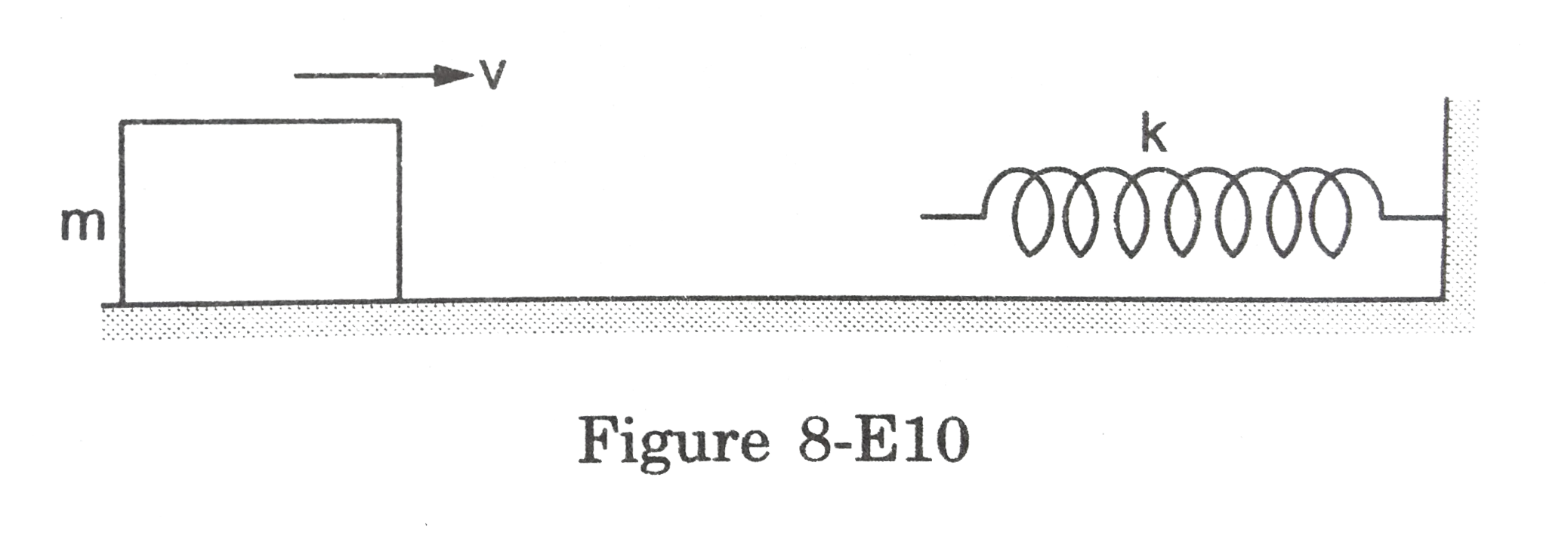A solid cylinder of mass 3kg is rolling on a horizontal surface with velocity 4ms−1. It collides with a horizontal spring of force constant 200Nm−1. The maximum compression produced in the spring will be :
0.7 m
0.2 m
0.5 m
0.6 m
The correct Answer is:D
To solve the problem of finding the maximum compression produced in the spring when a solid cylinder collides with it, we can follow these steps:
Step 1: Identify the given values
- Mass of the cylinder, m=3kg
- Velocity of the cylinder, v=4m/s
- Spring constant, k=200N/m
Step 2: Calculate the initial kinetic energy of the cylinder
The total kinetic energy KE of a rolling solid cylinder is given by the sum of its translational and rotational kinetic energy:
KE=12mv2+12Iω2
For a solid cylinder, the moment of inertia I is given by:
I=12mr2
And the relationship between linear velocity v and angular velocity ω is:
ω=vr
Substituting ω into the kinetic energy equation:
KE=12mv2+12(12mr2)(vr)2
This simplifies to:
KE=12mv2+14mv2=34mv2
Step 3: Substitute the values into the kinetic energy formula
Now, substituting the values of m and v:
KE=34×3kg×(4m/s)2
Calculating this gives:
KE=34×3×16=1444=36J
Step 4: Set up the energy conservation equation
At maximum compression x, the kinetic energy will be converted into the potential energy stored in the spring:
12kx2=KE
Substituting KE into the equation:
12kx2=36
Step 5: Solve for x2
Rearranging the equation to solve for x2:
x2=2×36k=72200=0.36
Step 6: Calculate x
Taking the square root to find x:
x=√0.36=0.6m
Conclusion
The maximum compression produced in the spring is:
0.6m
- Mass of the cylinder, m=3kg
- Velocity of the cylinder, v=4m/s
- Spring constant, k=200N/m
The total kinetic energy KE of a rolling solid cylinder is given by the sum of its translational and rotational kinetic energy:
Now, substituting the values of m and v:
At maximum compression x, the kinetic energy will be converted into the potential energy stored in the spring:
Rearranging the equation to solve for x2:
Taking the square root to find x:
The maximum compression produced in the spring is:
Similar Questions
A solid sphere of mass 2 kg is rolling on a frictionless horizontal surface with velocity 6m/s. It collides on the free end of an ideal spring whose other end is fixed. The maximum compression produced in the spring will be
(Force constant of the spring = 36 N/m)View SolutionA body of mass 5 kg moving with a speed of 1.5 m/s on a horizontal smooth surface collides with a nearly weightless spring of force constant k = 5 N/m. The maximum compression of the spring would be
 View Solution
View Solution
Knowledge Check
- Question 1 - Select One
A car of mass 1000 kg moving with a speed 18kmh−1 on a smooth road and colliding with a horizontally mounted spring of spring constant 6.25×103Nm−1. The maximum compression of the spring is
A1 mB2 mC3 mD4 m
A mass of 0.5kg moving with a speed of 1.5m/s on a horizontal smooth surface, collides with a nearly weightless spring of force constant k=50N/m The maximum compression of the spring would be.
View SolutionA block of mass m sliding n a smooth horizontal surface with velocity →v meets a long horizontal spring fixed ast one end and having spring constant k as shown n figure. Find the maximum compression of the spring. Will the velocity of the block be the same as v whenit comes back to the original position shown?
 View Solution
View SolutionAuto manufactures study the collision of cars with mounted spring of different spring constant. Consider a car of mass 1500 kg moving with a speed of 36kmh−1 on a smooth road and colliding with a horizontally mounted spring of spring constant 7.5×103Nm−1. Find the maximum compression of the spring .
View SolutionAuto manufactures study the collision of cars with mounted spring of different spring constant. Consider a car of mass 1500 kg moving with a speed of 36kmh−1 on a smooth road and colliding with a horizontally mounted spring of spring constant 7.5×103Nm−1. Find the maximum compression of the spring .
View SolutionA block of mass m moving with velocity v0 on a smooth horizontal surface hits the spring of constant k as shown. The maximum compression in spring is
 View Solution
View Solution
Two blocks A and B of mass 2 m and m respectively are connected to a massless spring of spring constant K. if A and B moving on the horizontal frictionless surface with velocity v to right. If A collides with C of mass m elastically and head on, then the maximum compressions of the spring will beView SolutionTwo blocks A and B of mass 2m and m respectively are connected to a massless spring of force constant K as shown in figure A and B are moving on the horizontal frcitionless surface with velocity v to right with underformed spring. If B collides with C elastically, then maximum compression of the spring will be
 View Solution
View Solution

